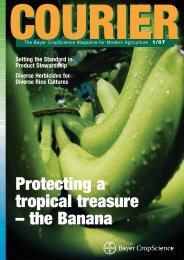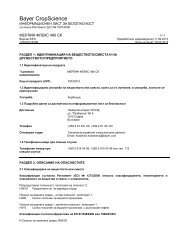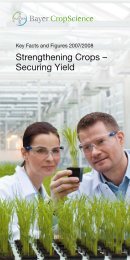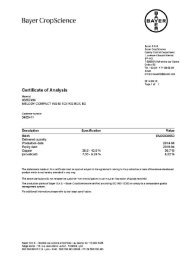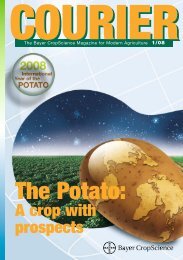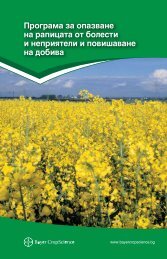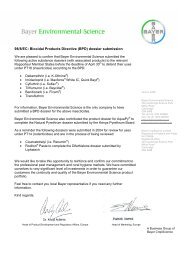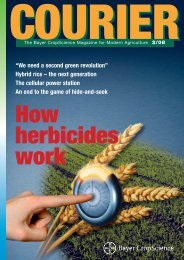For healthy potatoes - Bayer CropScience
For healthy potatoes - Bayer CropScience
For healthy potatoes - Bayer CropScience
Create successful ePaper yourself
Turn your PDF publications into a flip-book with our unique Google optimized e-Paper software.
Agriculture, in all its forms, inevitably<br />
means disruption of natural ecosystems.<br />
What is therefore important is that a balance<br />
is achieved between varied habitats<br />
on the one hand, and agricultural use of<br />
land on the other. This is certainly possible<br />
– because high environmental standards<br />
can be combined with productivity and<br />
profitability in agricultural systems.<br />
Extensive research efforts<br />
These days, the development of a new crop<br />
protection compound can take up to ten<br />
years. Before any products can be marketed,<br />
an extensive programme of research<br />
and development work is done to demonstrate<br />
the safety of the compound to people<br />
and the environment. An application to<br />
register a crop protection compound can<br />
only be made once a catalogue of requirements<br />
has been met. The requirements<br />
themselves are continually being reviewed<br />
and strengthened in order to ensure an ever<br />
more comprehensive characterization of<br />
the product. All of the studies done during<br />
the research and development stage, and<br />
the risk assessments based on them, are<br />
collected together to create a safety profile<br />
for the new crop protection compound.<br />
Existing products – those that are already<br />
on the market – must also be re-tested and<br />
re-classified when the time comes for them<br />
to be re-registered. Not all products are<br />
able to satisfy the complete set of requirements,<br />
and some fail to achieve regulatory<br />
approval.<br />
Among the required studies are tests<br />
relating to the sensitivity of standard<br />
species selected to represent the variety of<br />
non-target organisms that are likely to be<br />
exposed to the product in use, whether<br />
present on the ground, in the soil, or in<br />
water. These include algae, fish, water<br />
fleas, plants, earthworms, mites, parasitic<br />
wasps, bees, birds, and certain mammals,<br />
such as mice.<br />
However, tests done under laboratory<br />
conditions are only part of the story. Under<br />
the real environmental conditions of<br />
nature, not all organisms are equally<br />
exposed to crop protection compounds. If<br />
laboratory tests indicate sensitivity in a<br />
particular species, the product’s effects on<br />
it must also be tested under the more complex<br />
conditions of an intact ecosystem. <strong>For</strong><br />
example, in order to determine the safety<br />
of the product to aquatic communities, differing<br />
concentrations of test compound are<br />
applied to small experimental water bodies<br />
in so-called “mesocosm studies”: the<br />
dynamics of the treated ecosystem are then<br />
studied over a period of several months.<br />
Agricultural practice determines that<br />
only a proportion of the fields in a particular<br />
area of land are being treated with a<br />
particular crop protection compound at any<br />
given time. Scientists assessing the environmental<br />
compatibility of a product<br />
therefore take into consideration both the<br />
distribution of certain species (the proportion<br />
of time spent in a treated field) and<br />
their behaviour (for example the feeding<br />
habits of wood mice and water voles, partridges,<br />
larks or yellow wagtails). Socalled<br />
„generic studies“ are done on areas<br />
of land of between five and a hundred<br />
hectares in size and containing a number of<br />
crop types: they aim to establish which<br />
species typically live within these agricultural<br />
areas, and also to what extent they use<br />
crops and orchards as sources of food.<br />
These studies are sometimes run in parallel<br />
in more than one country. Since they do<br />
not involve the use of a particular crop protection<br />
compound, their findings can be<br />
applied to different products. Generic studies<br />
indicate the typical level of exposure to<br />
a product used in the agricultural landscape<br />
in question. With the help of geographical<br />
information systems and simulation<br />
models, the results of smaller studies<br />
can be extrapolated to cover larger agroecosystems.<br />
Good agricultural practices<br />
are key<br />
The success of our highly-refined crop<br />
production technologies depends on them<br />
being used responsibly by the farmer.<br />
Good agricultural practice and soil husbandry<br />
are important factors. <strong>Bayer</strong> Crop-<br />
Science contributes to sustainable agriculture<br />
through its support for, and promotion<br />
of Integrated Crop Management (ICM)<br />
and Integrated Pest Management (IPM).<br />
The idea behind ICM is to provide farmers<br />
with a method for protecting the environment<br />
within the economic framework they<br />
operate under. By developing and using<br />
ICM-Strategies tailored to local conditions,<br />
it is possible to produce crops economically<br />
and to protect biodiversity at the<br />
same time – independent of geographical<br />
location, the size of the farm, socio-economic<br />
factors and technical standards.<br />
2/06 COURIER 21





